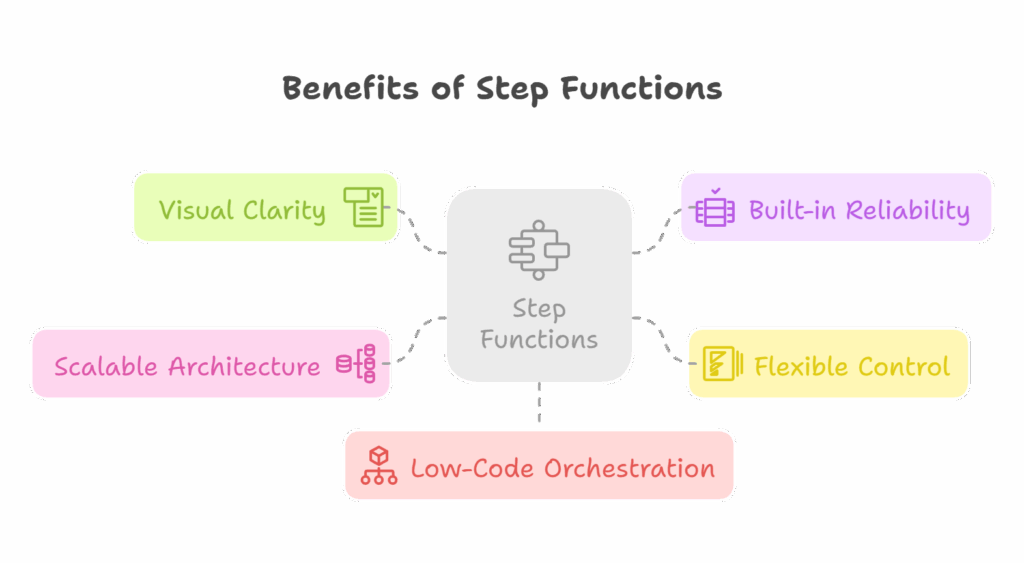Introduction
Modern applications are more event-driven than ever, from user logins and file uploads to automated notifications and AI tasks. But as these workflows grow more complex, stitching together backend services can quickly become a nightmare. Hard-coded logic, brittle scripts, and custom orchestration layers don’t scale well—especially when speed and reliability are crucial.
That’s where serverless workflow automation powered by AWS Amplify and AWS Step Functions comes in. Together, they offer a clean, scalable way to manage your application’s backend logic without drowning in infrastructure. Whether you’re building a fast-moving product or a large-scale cloud application, this duo helps you stay agile while keeping your backend organized and resilient.
AWS Amplify and Step Functions
AWS Amplify is a development platform that helps you build full-stack web and mobile apps faster. It takes care of the heavy lifting when it comes to setting up and managing your backend. Whether you need authentication, storage, APIs, or hosting, Amplify brings it all together in one place and integrates seamlessly with other AWS services. It’s especially handy if you’re looking to prototype quickly or scale without reworking your infrastructure.
AWS Step Functions is a service that lets you coordinate multiple AWS resources into automated workflows. Imagine having a flowchart where each block represents a task or microservice. Step Functions executes each task in the correct order, handles errors, and makes sure nothing slips through the cracks. You get visibility, reliability, and control, without needing to stitch everything together manually.
When used together, Amplify and Step Functions give you the ability to build and manage complex backend workflows in a way that’s both scalable and developer-friendly.
Why Use Step Functions with AWS Amplify?
AWS Amplify is excellent for setting up backend features like authentication, APIs, and storage with minimal effort. It connects you to powerful AWS services such as Amazon Cognito for authentication, AWS AppSync for GraphQL APIs, and Amazon S3 or DynamoDB for storage. But as your application logic becomes more complex, you may find yourself needing to coordinate a series of backend tasks like processing data, sending notifications, or triggering third-party APIs. That’s where Step Functions shine.
Here’s why Step Functions make a great addition to your Amplify-powered backend:
- Visual clarity: You can design and view workflows as state machines, making it easier to understand the flow of operations.
- Built-in reliability: Automatically handles retries, timeouts, and error catching without extra code.
- Flexible control: Supports sequential, parallel, and conditional task execution to suit a wide range of scenarios.
- Scalable architecture: Handles growing complexity without making your codebase harder to manage.
- Low-code orchestration: Lets you focus on business logic rather than boilerplate or glue code.

Together, Amplify and Step Functions offer a powerful, scalable, and developer-friendly approach to managing modern backend workflows.
Common Use Cases for Step Functions in Amplify Projects
When building with AWS Amplify, Step Functions can help organize your logic when multiple backend services need to work together. Some common use cases include:
- Multi-step form submissions: Capture user data, validate it, store it, and notify the user or admin, all in a reliable flow.
- Media processing: Automatically trigger a series of steps when a user uploads a video, like transcoding, storing metadata, and sending a completion notification.
- User registration workflows: After signup, create user profiles, send welcome emails, and apply custom business logic before granting full access.
- Scheduled data processing: Run nightly data aggregation, backups, or cleanup tasks across services.
- Third-party API coordination: Call external APIs in sequence or conditionally, with fail-safes built in.
- Data import/export (ETL): Automate complex ETL pipelines to move, transform, and load data across services like S3, DynamoDB, or external databases.
These patterns help keep your logic modular, testable, and easy to monitor. If your app is growing beyond single Lambda functions or simple workflows, it’s probably time to look into Step Functions.
How Step Functions Work: A Quick Primer
AWS Step Functions simplify the way you manage complex workflows by visually mapping out each step in a process. At the core is something called a state machine, which acts like a flowchart where each block represents a task, decision, or pause in the process.
Each state can interact with AWS resources, or make decisions based on conditions. Data flows from one step to the next, keeping everything organized and traceable.
A key benefit is built-in error handling. You don’t need to write extra code to manage failures or retries. Step Functions take care of that automatically.
You can also run multiple tasks at the same time, which helps speed up workflows when steps don’t depend on each other.
With monitoring and logging (using Amazon CloudWatch) built in, it’s easy to track what’s happening at every step, troubleshoot issues, and understand how your system is performing.
By pairing Step Functions with AWS Amplify, you get a reliable way to automate backend workflows while staying focused on building great features.
Key Benefits of Using AWS Amplify + Step Functions
Integrating AWS Amplify with Step Functions provides a range of advantages that streamline development and improve performance. Here’s a breakdown of the key benefits:
- Scalability: With AWS Amplify, there’s no need to manage infrastructure manually. As your application grows, Amplify and Step Functions automatically scale to handle more users without additional setup.
- Error Handling: Step Functions come with built-in retry mechanisms and fallback options, ensuring that workflows continue smoothly even if an error occurs, without the need for complex error management code.
- Visual Workflows: The visual interface provided by Step Functions allows developers to easily design, map out, and debug workflows. This is similar to drawing a flowchart, making it easier to understand the process and identify potential issues.
- Speed & Agility: Amplify’s CLI and visual editors let developers rapidly deploy and iterate on applications, helping teams get updates out quickly and efficiently.
- Integration: Amplify integrates seamlessly with AWS services like S3, Lambda, DynamoDB, and SageMaker, allowing you to build end-to-end solutions effortlessly.
- Security: Amplify’s built-in authentication combined with AWS IAM roles ensures your app is secure by design, protecting sensitive data and user information.
- Cost Efficiency: With both services, you pay only for what you use, meaning no upfront infrastructure costs or ongoing maintenance fees, keeping costs manageable.
How Serverless Changes the Game: Traditional vs. AWS Amplify + Step Functions
Wondering what sets serverless orchestration apart from traditional approaches? Here’s a quick side-by-side look to help you understand the shift:
| Feature | Traditional Backend | AWS Amplify + Step Functions |
|---|---|---|
| Infrastructure | Requires manual provisioning and scaling | Fully managed, auto-scaled by AWS |
| Workflow Orchestration Logic | Custom-written code (e.g., Node.js, Python) | Visual workflows with JSON and AWS Console |
| Failure Handling | Handled manually via try/catch and logs | Built-in retries, catch blocks, and fallback states |
| Cost Structure | Often fixed or overprovisioned | Pay only for what you use |
| Deployment | Needs full CI/CD pipelines | Simple Git-based or CLI-driven deployments |
This table highlights how AWS Amplify and Step Functions simplify infrastructure management, reduce complexity, and offer a more agile way to build and scale cloud-native applications.
Business Impact & Developer Advantages
Switching to Amplify with Step Functions isn’t just a technical upgrade. It’s a smarter way to build and scale.
Business Gains
- Faster Time to Market: Pre-built integrations and workflows cut development time.
- Scalable by Default: Your app grows without worrying about infrastructure.
- Lower Costs: Pay-as-you-go pricing eliminates overprovisioning.
Developer Wins
- Focus on Logic, Not Infrastructure: No need to manage servers or write orchestration code.
- Better Visibility: Visual workflows help debug and optimize easily.
- Seamless Iteration: Push updates quickly with minimal disruption.
Together, these advantages mean faster launches, smoother user experiences, and teams that can focus more on features than firefighting.
Conclusion
AWS Amplify and Step Functions aren’t just tools, they’re enablers. When used together, they help teams build modern, scalable applications without getting buried in infrastructure work. You get flexibility, faster releases, and better control over complex workflows, all while keeping your development experience smooth.
Whether you’re launching a fresh idea, modernising an existing system, or just experimenting with something new, this approach helps you build smart and scale faster, without unnecessary complexity.
At Compileinfy, we don’t just write code, we build solutions that scale! We’ve helped product teams streamline workflows, automate operations, and launch faster using serverless tools like AWS Amplify and Step Functions.
If you’re exploring a modern, scalable backend for your next project, let’s talk. Reach out to Compileinfy and see how we can help turn your backend vision into a future-ready reality.





